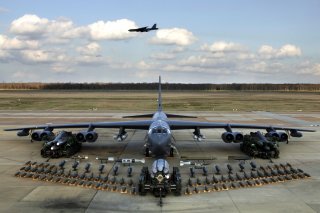B-52s as Missile Carriers: U.S. Air Force Completed Latest Test of Hypersonic Weapons
The test was a true mix of early Cold War technology with state-of-the-art twenty-first-century innovation.
There is little denying that hypersonic weapons could be a major game-changer for whatever power can develop the technology. Such missiles could travel several times faster than the speed of sound, be capable of maneuvering with computerized precision, and because their speed and force are so significant such a weapon could inflict damage through sheer “kinetic” impact rather than actually requiring an explosive.
A great fear has been the efforts undertaken by the Russian Federal and the People’s Republic of China to develop hypersonic missiles before the United States or its allies.
However, this month the United States Air Force took a major step forward towards the development of a hypersonic weapon following its final captive-carrying test of the AGM-183A Air-launched Rapid Response Weapon (ARRW), which was carried under the wing of a B-52 Stratofortess off the coast of Southern California.
It was a true mix of early Cold War technology with state-of-the-art twenty-first-century innovation, and the flight resulted in the successful transmission of telemetry and GPS data from the AGM-183A IMV-2 (Instrumented Measurement Vehicle) to Point Mugu Sea Range ground stations. The test verified system integration with the B-52 launch platform and telemetry while also practicing concepts of operations that will be utilized during the first Booster Test Flight scheduled for later this year.
This was the third captive carry test and, more importantly, was the first time an ARRW missile had been fully assembled. Additional ground and flight testing will also follow over the next two years.
“This is a major milestone for the program, the team and our Air Force,” said Brig. Gen. Heath Collins, Air Force program executive officer for weapons. “ARRW is the first step in bringing game-changing hypersonic capabilities to our Warfighters.”
Rapid Prototyping Project
The ARRW program was initiated as a rapid prototyping project aimed at delivering a conventional hypersonic weapons capability to the Air Force in the early 2020s. ARRW is designed to provide combatant commanders with the capabilities to destroy high-value, time-sensitive targets, but will also expand precision-strike weapon systems' capabilities by enabling rapid response strikes against heavily defended land targets.
“The event (last) week demonstrated the ability to communicate with the prototype weapon; the entire team is excited to take the next step and begin energetic flight test of our first air-launched hypersonic weapons,” said Lt. Col. Michael Jungquist, 419th Flight Test Squadron Commander and Global Power Bomber Combined Test Force Director. “These weapons will enable application of conventional firepower anywhere in the world at eye-watering speed.”
Hypersonic weapons have been a key priority of the United States Department of Defense’s National Defense Strategy and Missile Defense Review.
The Air Force has worked with the private sector in the development of the technology. Defense contractor Lockheed Martin has been among the companies to invest in the development and demonstration of hypersonic technology over the course of the past three decades, and the company is among those at the forefront of hypersonic capabilities, systems and engineering.
The team from Lockheed Martin was involved with last week’s tests, which originated at Edwards Air Force Base, California.
“The team overcame significant challenges driven by the COVID-19 pandemic to achieve this significant milestone for the program,” said Dave Berganini, ARRW program director at Lockheed Martin Missiles and Fire Control. “This captive carry mission is the pre-cursor for our first booster test flight planned for early 2020s.”
Peter Suciu is a Michigan-based writer who has contributed to more than four dozen magazines, newspapers and websites. He is the author of several books on military headgear including A Gallery of Military Headdress, which is available on Amazon.com.
Image: Flickr / U.S. Air Force

